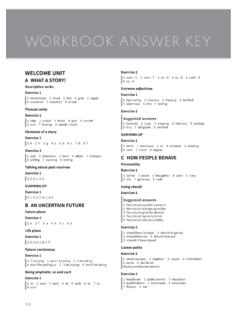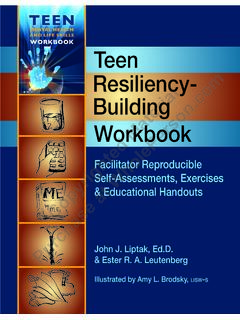Transcription of TEACHER’S BOOK 2 B
1 teacher 'S book 2 B1. Brian Hart, Herbert Puchta, Jeff Stranks & Peter Lewis-Jones Acknowledgements The publishers are grateful to the following contributors: Blooberry: text design and layouts Claire Parson: cover design Vicky Saumell: author of Using the Digital Resources University Printing House, Cambridge CB2 8BS, United Kingdom Cambridge University Press is part of the University of Cambridge. It furthers the University's mission by disseminating knowledge in the pursuit of education, learning and research at the highest international levels of excellence. Information on this title: Cambridge University Press 2015. This publication is in copyright.
2 Subject to statutory exception and to the provisions of relevant collective licensing agreements, no reproduction of any part may take place without the written permission of Cambridge University Press. First published 2015. Printed in the XXXXX by XXXXXX. A catalogue record for this publication is available from the British Library ISBN 978-1-107-50915-3 Student's book Level 2. ISBN 978-1-107-50910-8 Student's book with Online workbook and Online Practice Level 2. ISBN 978-1-107-50917-7 workbook with Online Practice Level 2. ISBN 978-1-107-50918-4 Combo A with online workbook and Online Practice Level 2. ISBN 978-1-107-50921-4 Combo B with online workbook and Online Practice Level 2.
3 ISBN 978-1-107-50922-1 teacher 's book Level 2. ISBN 978-1-107-50923-8 Class Audio CDs Level 2. ISBN 978-1-107-50925-2 Video DVD Level 2. ISBN 978-1-107-50931-3 Presentation Plus DVD-ROM Level 2. ISBN 978-1-107-50932-0 Presentation Plus DVD-ROM A Level 2. ISBN 978-1-107-50933-7 Presentation Plus DVD-ROM B Level 2. Additional resources for this publication at Cambridge University Press has no responsibility for the persistence or accuracy of URLs for external or third-party internet websites referred to in this publication, and does not guarantee that any content on such websites is, or will remain, accurate or appropriate. Information regarding prices, travel timetables, and other factual information given in this work is correct at the time of first printing but Cambridge University Press does not guarantee the accuracy of such information thereafter.
4 CONTENTS. Map of Student's book 4. Introduction 6. teacher 's notes and keys Welcome unit 18. 1 Amazing people 26. 2 The ways we learn 32. Exam Practice and Review 39. 3 That's entertainment 40. 4 Social networking 48. Exam Practice and Review 55. 5 My life in music 56. 6 Making a difference 63. Exam Practice and Review 70. 7 Future fun 71. 8 Science counts 78. Exam Practice and Review 85. 9 What a job! 86. 10 Keep healthy 92. Exam Practice and Review 98. 11 Making the news 99. 12 Playing by the rules 106. Exam Practice and Review 113. Pronunciation 114. Get it right! 117. workbook answer key 121. 3. STUDENT'S book CONTENTS.
5 4 . I NTRO DUC TIO N. 5. INTRODUC TION. COURSE METHODOLOGY teens are overwhelmed by their emotions, and these can exert a strong influence both positive and negative on Solid skills and language work their behaviour and their attitudes. The integration of Think is a six-level course for adolescents and teenagers both emotional qualities and cognitive processes is key from A1 to C1-levels of the Common European Framework to the successful development of students' cognition, of Reference (CEFR). Based on a carefully crafted skills and their understanding of the world, and their development language syllabus, the course helps students develop their towards becoming responsible human beings.
6 Receptive and productive language skills and strategies, and Think supports you as a teacher in helping your students provides a systematic approach to competence training to integrate their emotional reactions and cognitive processes. help them prepare for their Cambridge English exams. It achieves this through an invaluable and comprehensive The authors have put great emphasis on the continuous support system aimed at systematically developing your extension of students' lexical knowledge by including students' thinking skills, their awareness of values and two vocabulary sections within each unit, together with their self - esteem , whilst at the same time building their WordWise activities in every other unit.
7 WordWise aims language skills and competencies. This in turn will increase to develop awareness of and competence in using high- students' awareness of the issues that are important to frequency words and chunks of language, important their present and future lives, deepen their understanding collocations, and phrasal verbs, as well as increasing of important social and global issues, and enable them to fluency. In addition, an entertaining and thought- become more caring and thoughtful young adults. provoking teen photostory offers natural contexts for the presentation and practice of phrases for fluency. These are high-frequency lexico-grammatical chunks of language used in spoken communication.
8 At the lower levels, Think focuses on building basic Students are guided through the grammar via inductive cognitive tools, capabilities that are required for the exercises, which support them in their grasp of both form development of so-called higher order thinking skills and meaning. The structures are then practised through a that will be addressed later on in your students' English sequence of exercises in which students learn how to apply language development. Examples of such basic thinking them in motivating and communicative activities. skills include Comparing and Contrasting, Categorising, Adolescents and teenagers do not always find it easy to Sequencing, Focusing Attention, Exploring Space, Time and participate in speaking activities, especially when they Numbers and Understanding Cause and Effect.
9 Are asked to say what they think and feel. Think takes this The higher levels of Think focus on the development of concern seriously. Based on research in teenage classrooms more advanced thinking skills. The B2 and C1 levels guide in many different countries, the authors of Think have students in developing critical thinking skills. According to found that adolescents and teens generally find it easier to Cottrell (2011), these include such things as ascertaining engage in thinking activities if they are embedded in the the extent to which we believe what we see or hear, framework of topics and texts that they can emotionally determining whether something is true, arguing one's connect with, and especially those that are far from their case, identifying when further information is required and day-to-day realities.
10 This remoteness gives students the selecting information for a given purpose. opportunity to look outwards rather than inwards, and in The activities in the books have been carefully designed to so doing feel less self -conscious. So in the first few levels offer an appropriate level of challenge, taking into account of the course, units often start somewhat removed from the fact that students are tackling/approaching them in a students' own lives, presenting stories of extremes, set in language they are still learning and not in their own. faraway places and cultures but whose protagonists the heroes and heroines of these stories young people can identify with.






